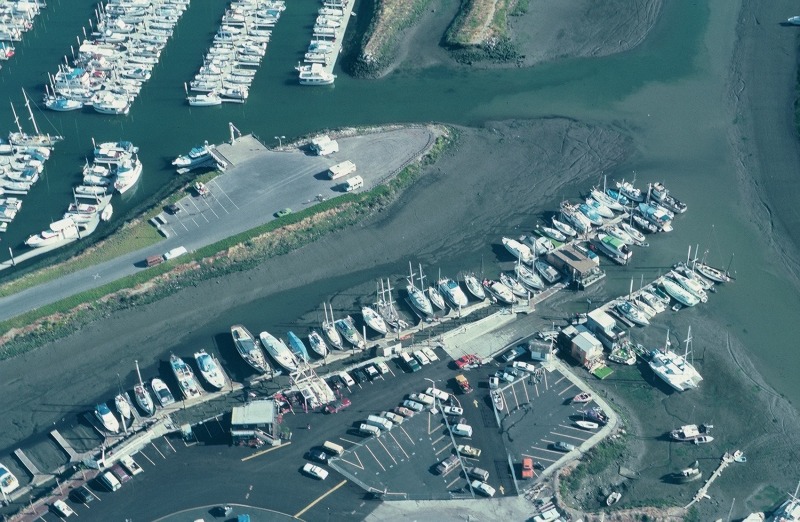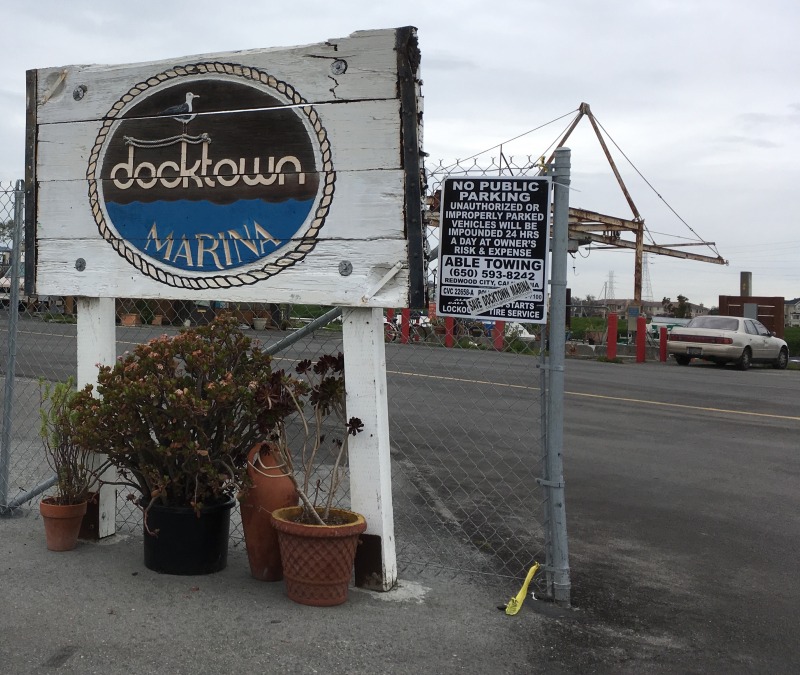
Bohemia After Dark: The Final Days of Docktown
The lights are slowly going out on the Docktown liveaboard community in Redwood City. According to the city’s Docktown Plan, residents were required to move out by February 28, 2018, but a 60-day stay was granted by the courts in response to a lawsuit filed by one of the Docktown residents, so the final date has been pushed back to the end of April. Residents with school-age children can stay until June 30 to complete the school year. Most of the residents have moved out already in any case, and only a dozen or so remain out of the 70 owners and tenants who until recently called Docktown home.
Docktown is an anachronism, a vestige of an earlier age. There are very few liveaboard communities left in the Bay Area, and Docktown was the last one in Redwood City. Docktown’s demise is the result of relentless development pressure in the Bay Area, and a growing intolerance for any kind of community that doesn’t include manicured landscaping surrounding high-density housing. This is especially true along the waterfront, where the people buying multi-million-dollar condos don’t want their million-dollar views cluttered up with old boats in a slowly decomposing marina.

Docktown’s fate was sealed when Citizens for the Public Trust and Ted Hannig, a nearby resident and lawyer, filed suit alleging Docktown was an illegal liveaboard community because it was built on state lands that are governed by the state’s Public Trust Doctrine. Plaintiffs claimed that a residential community was a violation of that doctrine, because residential use reserves for private benefit lands that should be available to all residents of the state. A letter from the Attorney General’s Office to the State Lands Commission seems to confirm that interpretation, although the case never went to court. Redwood City settled the suit before trial, so the legal issues were never adjudicated, leading some residents to suggest that the city viewed the lawsuit as an opportunity to repurpose the land under the cover of the settlement and the Public Trust Doctrine.
That said, Redwood City has made significant efforts to minimize the impact of the order to vacate on Docktown residents. The city has allocated $20.4 million to purchase residents’ vessels or barge-based homes, and has also offered relocation assistance to residents who need it. Unfortunately, the cost of housing in Redwood City is so high that even with assistance, some of the residents have not been, or will not be, able to find alternative housing in that market.
There are currently three lawsuits pending that have been filed by the residents of Docktown Marina. In the first suit, plaintiffs allege that Redwood City lacked jurisdiction to enter into the settlement agreement between the city and Citizens for the Public Trust because the land in question is under jurisdiction of the Port of Redwood City, which is a separate legal entity. Plaintiffs further claim that the settlement was illegal and that the Docktown Plan is void.
The second suit is a class action filed on behalf of the residents arguing that the city must provide more assistance in relocating the displaced residents of Docktown. And the third suit argues that Redwood City must do an Environmental Impact Report under the California Environmental Quality Act.
These latter two lawsuits, if decided in favor of plaintiffs, may delay the final implementation of the Docktown Plan, but it is the first suit that raises some important legal questions regarding liveaboards and the Public Trust. According to the attorney for the Docktown residents, the State Lands Commission (SLC) has never held hearings on the status of liveaboards on Public Trust lands, so the issue has never been adjudicated. According to the suit, SLC cannot rule that liveaboards are illegal on Public Trust lands, because it is not legal to make such decisions without adequate fact finding. Furthermore, the settlement between Redwood City and Citizens for the Public Trust states that Docktown must conform to state law, but given the lack of fact finding, this raises a simple question, “What is state law?”
Local circumstances matter in issues like this, and the issues surrounding Docktown are unique. Other jurisdictions, facing somewhat similar issues, have found ways to retain liveaboard or residential communities that were built on Public Trust lands, or at least extend their terms of occupancy. But such decisions depend on the specific terms that the local entity agreed to when the SLC transferred management of these lands to their jurisdiction. So even if the courts or the SLC rule on the legality of liveaboards at Docktown, this ruling may or may not apply broadly to other jurisdictions.

Nonetheless, there are a number of issues related to Docktown that should concern all of us who cherish access to the Bay. The first is the relentless development pressure in and around the Bay Area. Waterfront is increasingly prime real estate, and there is no higher value use for waterfront land than housing. There is a launch ramp at Docktown, although the extreme tidal nature of Redwood Creek means that the ramp is only available when the tide is high. The owner of the land adjacent to Docktown has proposed a 131 unit residential development, and the preliminary drawings show a marina and launch ramp, along with space for a public park.
But the development is a long way from complete, and both the marina and the launch ramp could disappear before the project is finished. According to a spokesperson for the city, they have not yet determined what kind of access will be available once the land has been redeveloped, and questions of access will be addressed as development proposals work their way through the permitting process. It would be ironic if the Public Trust Doctrine was used to shut down Docktown — which does provide water access for boaters — and the final development includes nothing more than a walking path along the water, with no real water access for the citizens of the state.
The second concern is the increasingly fragile nature of the Bay Area boating ecosystem. Currently, there are no boatyards in the South Bay, and boating-related services have largely been priced out of the area. Redwood Creek remains an active boating venue, and is still home to several marinas, yacht clubs and sailing schools, and Redwood Creek is popular with kayakers and paddleboarders. But despite the popularity of the venue, water access is increasingly restricted, and large swaths of land that once supported boating and marine-related services have been converted to residential use. This problem is not unique to Redwood City, but is true throughout the Bay Area.
Like the working waterfront before it, the recreational waterfront is slowly disappearing. Floating communities like Docktown are being squeezed out by development and the gentrification of lands that once were considered marginal. The anachronistic Docktown has always been a place where people who marched to the beat of a different drummer could find a community of like-minded free spirits. Even if the marina remains, it will be different, replaced by a well-regulated facility with no more than 10 percent liveaboards, thereby ensuring that even if the marina is full, it is 90 percent empty of people most of the time. The lights are going out at Docktown, and even if the remaining residents are successful in their lawsuits, that community will never be the same.
For more information about Docktown and the Docktown Plan, go to www.redwoodcity.org and find the Docktown Marina tab.

Hello,
I had to sell my beautiful floating home that I owned for 18 years. I painstakingly remodeled the antique WWII transport vessel. It was even featured on HGTV and the producers of Oprah called for me to be on an episode about living in small places
Spaces They gave me 24 hour notice to get to Chicago and I just could not do it. But I was very flattered. I helped a lot of people fix up their boats and I help decorate the Yacht Club
As a designer my boat was one of the most unique inside and out
I loved it and I miss it. I only sold because I was bullied into it I was told I had to move. I was intimidated I had no choice. I was told. I must sell and the boat must be moved. There was no place to move it. I looked for years
If anyone reads this please let me know. I would like to sue Redwood City for taking one of the best things in my life my home away from me. I miss it all the time. It’s very sad to me